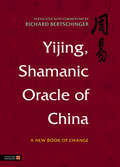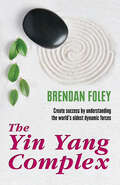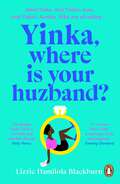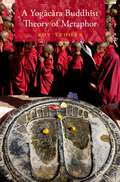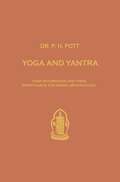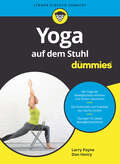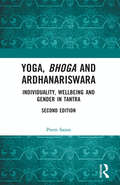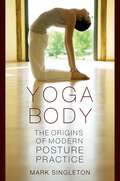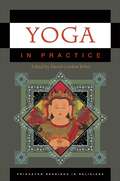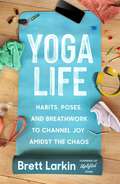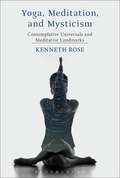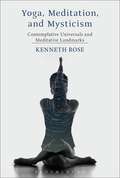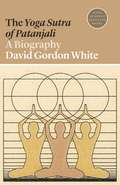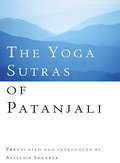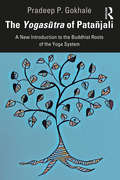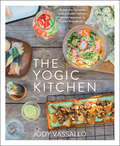- Table View
- List View
Yijing, Shamanic Oracle of China: A New Book of Change (PDF)
by Richard BertschingerFor the Chinese, the destiny of each individual and the cosmos have always been inextricably linked, and for two thousand years the Yijing, or the Book of Change, has exercised the best minds in the Orient. Richard Bertschinger, author of The Secret of Everlasting Life (the first translation of The Can Tong Qi), has worked from the classical commentaries to make a fresh and up-to-date translation for the modern world. Marriage, business ventures, journeys, military ventures, disputes, world affairs, personal problems, health or money issues, all are grist for the mill of the Book of Change. Through pondering the lines, studying their poetry, and devoting ourselves to its meaning, the heart of the ancients is clear. We pick up perhaps in a way we never could have conceived of, how to guide and direct our lives. With an introduction that explains the underlying structure and philosophy of the Book of Change, as well as its history, and a detailed explanation of how to throw the yarrow sticks, or the coins, the novice reader is given everything they need to take their first steps in consulting the ancient oracle, and those already familiar with established translations will find this fresh translation from the original texts clear and illuminating.
The Yin Yang Complex: Create success by understanding one of the world’s oldest dynamic forces
by Brendan FoleyIn The Yin Yang Complex you will be taken on a journey of discovery that will unearth the reason why the world is in its current state and why you have evolved in the manner that you have. From the Mesolithic period to the modern day, we explore how we have become so unbalanced. He takes ancient knowledge and applies it to our lives today, our businesses, the environment and we see what we can learn. Each chapter has exercises associated with it that will allow you to personally explore your own balance and that in your life. You will learn the keys to great relationships, successful business and all other aspects of your life. This book will give you a comprehensive understanding of the masculine and feminine energies.
Yinka, Where is Your Huzband?: The hilarious and heartfelt romcom everyone is talking about in 2022
by Lizzie Damilola Blackburn'Hilarious, insightful and so uplifting' Beth O'Leary 'Such a warm, funny and relatable book' Jendella Benson -------------------------Yinka wants to find love. Her mum wants to find it for her. She also has too many aunties who frequently pray for her delivery from singledom, a preference for chicken and chips over traditional Nigerian food, and a bum she's sure is far too small as a result. Oh, and the fact that she's a thirty-one-year-old South-Londoner who doesn't believe in sex before marriage is a bit of an obstacle too... When her cousin gets engaged, Yinka commences 'Operation Find A Date for Rachel's Wedding'. Armed with a totally flawless, incredibly specific plan, will Yinka find herself a huzband? What if the thing she really needs to find is herself? MARIE CLAIRE 'BEST BOOKS OF 2022' AND FEBRUARY PICK FOR MALALA'S LITERATI BOOKCLUB-------------------------Your favourite authors have all fallen in love with Yinka'The spiritual heir to Bridget Jones's Diary, while bringing something entirely fresh and modern to the table' Emily Henry, You and Me on Vacation'Warm and fun and sweet' Marian Keyes, Again, Rachel'Glorious debut! Read it over two nights and loved it!' Nikki May, Wahala 'Beautifully observed, warm and deeply human, Yinka is a meditation on family and friendship, on love and self-love' Josie Silver, One Night on the Island 'A joyful, pacy romp. Yinka's world is both hilarious and poignant' Irenosen Okojie MBE, Butterfly Fish 'A story about friendship, family, romance, and the most important quest of all - loving and accepting yourself' Lauren Ho, Last Tang Standing 'A beautiful, big hearted story about friendship, family, and love' Emiko Jean, Tokyo Ever After 'Yinka is the most loveable character you'll meet' Lolá Ákínmádé Åkerström, In Every Mirror She's Black 'Funny, charming, warm. A book that will make your heart smile' Milly Johnson, My One True North 'A gorgeous, easy read, but with real depth to its punchy chapters. Extraordinary' Lizzy Dent, The Summer JobAnd everyone else loves her too'Peckham's Bridget Jones' Evening Standard'Incredibly relatable' Marie Claire, Best Books of 2022'A fresh take on culture clashes, female friendship and the stigma about being single' Heat Magazine'A clever twist on the romcom archetype' Daily Mail'Fabulously fun' Prima'One of the talked-about debut novels' - The Sunday Times'More than a book about a woman looking for a man. It addresses female friendships, black beauty standards and religion' Mail on Sunday
A Yog=ac=ara Buddhist Theory of Metaphor
by Roy TzoharBuddhist philosophy is fundamentally ambivalent toward language. Language is paradoxically seen as both obstructive and necessary for liberation. In this book, Roy Tzohar delves into the ingenious response to this tension from the Yogacara school of Indian Buddhism: that all language-use is metaphorical. Exploring the profound implications of this claim, Tzohar makes the case for viewing the Yogacara account as a full-fledged theory of meaning, one that is not merely linguistic, but also applicable both in the world as well as in texts. Despite the overwhelming visibility of figurative language in Buddhist philosophical texts, this is the first sustained and systematic attempt to present an indigenous Buddhist theory of metaphor. By grounding the Yogacara pan-metaphorical claim in a broader intellectual context, of both Buddhist and non-Buddhist schools, the book uncovers an intense philosophical conversation about metaphor and language that reaches across sectarian lines. Tzohar's analysis radically reframes the Yogacara controversy with the Madhyamaka school of philosophy, sheds light on the Yogacara application of particular metaphors, and explicates the school's unique understanding of experience.
A Yog=ac=ara Buddhist Theory of Metaphor
by Roy TzoharBuddhist philosophy is fundamentally ambivalent toward language. Language is paradoxically seen as both obstructive and necessary for liberation. In this book, Roy Tzohar delves into the ingenious response to this tension from the Yogacara school of Indian Buddhism: that all language-use is metaphorical. Exploring the profound implications of this claim, Tzohar makes the case for viewing the Yogacara account as a full-fledged theory of meaning, one that is not merely linguistic, but also applicable both in the world as well as in texts. Despite the overwhelming visibility of figurative language in Buddhist philosophical texts, this is the first sustained and systematic attempt to present an indigenous Buddhist theory of metaphor. By grounding the Yogacara pan-metaphorical claim in a broader intellectual context, of both Buddhist and non-Buddhist schools, the book uncovers an intense philosophical conversation about metaphor and language that reaches across sectarian lines. Tzohar's analysis radically reframes the Yogacara controversy with the Madhyamaka school of philosophy, sheds light on the Yogacara application of particular metaphors, and explicates the school's unique understanding of experience.
Yoga and Yantra: Their Interrelation and Their Significance for Indian Archaeology (Verhandelingen van het Koninklijk Instituut voor Taal-, Land- en Volkenkunde)
by Philipp H. PottYoga auf dem Stuhl für Dummies (Für Dummies)
by Larry Payne Don HenryAlles, was Sie für Yoga brauchen, ist ein Stuhl. Larry Payne und Don Henry zeigen Ihnen in diesem Buch, wie Sie dank der Stabilität und Sicherheit, die Ihnen ein Stuhl bietet, Yoga praktizieren können - auch, wenn Sie in Ihrer Mobilität eingeschränkt sind. Das Buch enthält viele Illustrationen und Beschreibungen traditioneller Yoga-Übungen, die Sie auch im Sitzen ausführen können. So kann jeder von der entspannenden und stresslindernden Wirkung von Yoga profitieren, sei es nach einer Verletzung, im fortgeschrittenen Alter, in der Schwangerschaft und vieles mehr. Stellen Sie mit diesem Buch Ihren eigenen Übungsplan für zu Hause, unterwegs oder im Büro zusammen. So bleiben Sie auch im Sitzen aktiv!
Yoga, Bhoga and Ardhanariswara: Individuality, Wellbeing and Gender in Tantra
by Prem SaranThis book offers a social–scientific interpretation of the Hindu and Buddhist traditions of Tantra dating back 15 centuries. It is a self-reflexive study approached with an insider’s empathy and the perspective of an Indologist, anthropologist, mystic and practitioner of the cult. The work includes a discussion of non-modern Indic themes: mandala as a trope and its manifestations in South Asian regions such as Nepal; yoga and Indic individuality; the concept of bhoga; disciplined wellbeing; gender; and Indic axiology. Using personal praxis to inform his research, the author examines three core themes within Tantra — a ‘holonic’/mandalic individuality that conduces to mystical experience; a positive valorisation of pleasure and play; and cultural attitudes of gender-mutuality and complementarity, as neatly encapsulated in the icon of Shiva as Ardhanariswara. This analysis, as captured by the Tantric mandalas of deities in intimate union, leads to his compelling metathesis that Tantra serves as a permanent counterculture within the Indic civilization. This second edition, with a new Afterword, will greatly interest those in anthropology, South Asian studies, religious studies, gender studies, psychology and philosophy, as also the general reader.
Yoga, Bhoga and Ardhanariswara: Individuality, Wellbeing and Gender in Tantra
by Prem SaranThis book offers a social–scientific interpretation of the Hindu and Buddhist traditions of Tantra dating back 15 centuries. It is a self-reflexive study approached with an insider’s empathy and the perspective of an Indologist, anthropologist, mystic and practitioner of the cult. The work includes a discussion of non-modern Indic themes: mandala as a trope and its manifestations in South Asian regions such as Nepal; yoga and Indic individuality; the concept of bhoga; disciplined wellbeing; gender; and Indic axiology. Using personal praxis to inform his research, the author examines three core themes within Tantra — a ‘holonic’/mandalic individuality that conduces to mystical experience; a positive valorisation of pleasure and play; and cultural attitudes of gender-mutuality and complementarity, as neatly encapsulated in the icon of Shiva as Ardhanariswara. This analysis, as captured by the Tantric mandalas of deities in intimate union, leads to his compelling metathesis that Tantra serves as a permanent counterculture within the Indic civilization. This second edition, with a new Afterword, will greatly interest those in anthropology, South Asian studies, religious studies, gender studies, psychology and philosophy, as also the general reader.
Yoga Body: The Origins of Modern Posture Practice
by Mark SingletonYoga is so prevalent in the modern world--practiced by pop stars, taught in schools, and offered in yoga centers, health clubs, and even shopping malls--that we take its presence, and its meaning, for granted. But how did the current yoga boom happen? And is it really rooted in ancient Indian practices, as many of its adherents claim? In this groundbreaking book, Mark Singleton calls into question many commonly held beliefs about the nature and origins of postural yoga (asana) and suggests a radically new way of understanding the meaning of yoga as it is practiced by millions of people across the world today. Singleton shows that, contrary to popular belief, there is no evidence in the Indian tradition for the kind of health and fitness-oriented asana practice that dominates the global yoga scene of the twenty-first century. Singleton's surprising--and surely controversial--thesis is that yoga as it is popularly practiced today owes a greater debt to modern Indian nationalism and, even more surprisingly, to the spiritual aspirations of European bodybuilding and early 20th-century women's gymnastic movements of Europe and America, than it does to any ancient Indian yoga tradition. This discovery enables Singleton to explain, as no one has done before, how the most prevalent forms of postural yoga, like Ashtanga, Bikram and "Hatha" yoga, came to be the hugely popular phenomena they are today. Drawing on a wealth of rare documents from archives in India, the UK and the USA, as well as interviews with the few remaining, now very elderly figures in the 1930s Mysore asana revival, Yoga Body turns the conventional wisdom about yoga on its head.
Yoga Body: The Origins of Modern Posture Practice
by Mark SingletonYoga is so prevalent in the modern world--practiced by pop stars, taught in schools, and offered in yoga centers, health clubs, and even shopping malls--that we take its presence, and its meaning, for granted. But how did the current yoga boom happen? And is it really rooted in ancient Indian practices, as many of its adherents claim? In this groundbreaking book, Mark Singleton calls into question many commonly held beliefs about the nature and origins of postural yoga (asana) and suggests a radically new way of understanding the meaning of yoga as it is practiced by millions of people across the world today. Singleton shows that, contrary to popular belief, there is no evidence in the Indian tradition for the kind of health and fitness-oriented asana practice that dominates the global yoga scene of the twenty-first century. Singleton's surprising--and surely controversial--thesis is that yoga as it is popularly practiced today owes a greater debt to modern Indian nationalism and, even more surprisingly, to the spiritual aspirations of European bodybuilding and early 20th-century women's gymnastic movements of Europe and America, than it does to any ancient Indian yoga tradition. This discovery enables Singleton to explain, as no one has done before, how the most prevalent forms of postural yoga, like Ashtanga, Bikram and "Hatha" yoga, came to be the hugely popular phenomena they are today. Drawing on a wealth of rare documents from archives in India, the UK and the USA, as well as interviews with the few remaining, now very elderly figures in the 1930s Mysore asana revival, Yoga Body turns the conventional wisdom about yoga on its head.
Yoga in Practice
by David Gordon WhiteYoga is a body of practice that spans two millennia and transcends the boundaries of any single religion, geographic region, or teaching lineage. In fact, over the centuries there have been many "yogas"--yogas of battlefield warriors, of itinerant minstrels and beggars, of religious reformers, and of course, the yogas of mind and body so popular today. Yoga in Practice is an anthology of primary texts drawn from the diverse yoga traditions of India, greater Asia, and the West. This one-of-a-kind sourcebook features elegant translations of Hindu, Buddhist, Jain, and even Islamic yogic writings, many of them being made available in English for the very first time. Collected here are ancient, colonial, and modern texts reflecting a broad range of genres, from an early medical treatise in Sanskrit to Upanishadic verses on sacred sounds; from a Tibetan catechetical dialogue to funerary and devotional songs still sung in India today; and from a 1930s instructional guide by the grandfather of contemporary yoga to the private papers of a pioneer of tantric yoga in America. Emphasizing the lived experiences to be found in the many worlds of yoga, Yoga in Practice includes David Gordon White's informative general introduction as well as concise introductions to each reading by the book's contributors.
Yoga in Practice
by David Gordon WhiteYoga is a body of practice that spans two millennia and transcends the boundaries of any single religion, geographic region, or teaching lineage. In fact, over the centuries there have been many "yogas"--yogas of battlefield warriors, of itinerant minstrels and beggars, of religious reformers, and of course, the yogas of mind and body so popular today. Yoga in Practice is an anthology of primary texts drawn from the diverse yoga traditions of India, greater Asia, and the West. This one-of-a-kind sourcebook features elegant translations of Hindu, Buddhist, Jain, and even Islamic yogic writings, many of them being made available in English for the very first time. Collected here are ancient, colonial, and modern texts reflecting a broad range of genres, from an early medical treatise in Sanskrit to Upanishadic verses on sacred sounds; from a Tibetan catechetical dialogue to funerary and devotional songs still sung in India today; and from a 1930s instructional guide by the grandfather of contemporary yoga to the private papers of a pioneer of tantric yoga in America. Emphasizing the lived experiences to be found in the many worlds of yoga, Yoga in Practice includes David Gordon White's informative general introduction as well as concise introductions to each reading by the book's contributors.
Yoga Life: Habits, Poses, and Breathwork to Channel Joy Amidst the Chaos
by Brett Larkin&“Brett translates the magic of ancient yoga for those who need it most.&” —James Nestor, New York Times bestselling author of BreathOverwhelmed? Overscheduled? Want to access the benefits of yoga, but can&’t seem to make it to the mat? Beat stress with a yoga ritual that works for you in 20-minutes or less. Featuring adaptations for anxiety, weight loss, injury, and prenatal yoga, this "playful and real" (Elena Brower) guide is a must-read for beginners and seasoned yoga teachers alike. We all know that yoga can calm your mind and heal your body, but let&’s be real: It can be hard to cram one more thing into your messy, stressful, time-crunched life. Good news! If you're not making it to the mat, the problem isn&’t you—it&’s the yoga you&’re practicing. Award-winning instructor and Uplifted Yoga founder Brett Larkin is here to help you design an adaptable, personalized practice, and cut to the chase with quick yoga habits that soothe your soul. With the support of quizzes and thirty book-exclusive companion videos you&’ll learn: A five-step method to design a personal practice that works for your schedule. How to adapt your practice to meet your physical, mental, and emotional needs. More than a dozen yoga habits that will help you calm your mind and body, even if you never manage to make it to the mat. Grounded in the wisdom of yoga&’s original texts, Brett reminds us that yoga was always meant to fit easily into our everyday lives. Whether you&’re a beginner or a life-long practitioner, Yoga Life is your new go-to for a personal, transformative, joyful at-home practice to strengthen your mind, body, and spirit.
Yoga, Meditation, and Mysticism: Contemplative Universals and Meditative Landmarks
by Kenneth RoseContemplative experience is central to Hindu yoga traditions, Buddhist meditation practices, and Catholic mystical theology, and, despite doctrinal differences, it expresses itself in suggestively similar meditative landmarks in each of these three meditative systems. In Yoga, Meditation and Mysticism, Kenneth Rose shifts the dominant focus of contemporary religious studies away from tradition-specific studies of individual religious traditions, communities, and practices to examine the 'contemplative universals' that arise globally in meditative experience. Through a comparative exploration of the itineraries detailed in the contemplative manuals of Theravada Buddhism, Patañjalian Yoga, and Catholic mystical theology, Rose identifies in each tradition a moment of sharply focused awareness that marks the threshold between immersion in mundane consciousness and contemplative insight. As concentration deepens, the meditator steps through this threshold onto a globally shared contemplative itinerary, which leads through a series of virtually identical stages to mental stillness and insight. Rose argues that these contemplative universals, familiar to experienced contemplatives in multiple traditions, point to a common spiritual, mental, and biological heritage. Pioneering the exploration of contemplative practice and experience with a comparative perspective that ranges over multiple religious traditions, religious studies, philosophy, neuroscience, and the cognitive science of religion, this book is a landmark contribution to the fields of contemplative practice and religious studies.
Yoga, Meditation, and Mysticism: Contemplative Universals and Meditative Landmarks
by Kenneth RoseContemplative experience is central to Hindu yoga traditions, Buddhist meditation practices, and Catholic mystical theology, and, despite doctrinal differences, it expresses itself in suggestively similar meditative landmarks in each of these three meditative systems. In Yoga, Meditation and Mysticism, Kenneth Rose shifts the dominant focus of contemporary religious studies away from tradition-specific studies of individual religious traditions, communities, and practices to examine the 'contemplative universals' that arise globally in meditative experience. Through a comparative exploration of the itineraries detailed in the contemplative manuals of Theravada Buddhism, Patañjalian Yoga, and Catholic mystical theology, Rose identifies in each tradition a moment of sharply focused awareness that marks the threshold between immersion in mundane consciousness and contemplative insight. As concentration deepens, the meditator steps through this threshold onto a globally shared contemplative itinerary, which leads through a series of virtually identical stages to mental stillness and insight. Rose argues that these contemplative universals, familiar to experienced contemplatives in multiple traditions, point to a common spiritual, mental, and biological heritage. Pioneering the exploration of contemplative practice and experience with a comparative perspective that ranges over multiple religious traditions, religious studies, philosophy, neuroscience, and the cognitive science of religion, this book is a landmark contribution to the fields of contemplative practice and religious studies.
The "Yoga Sutra of Patanjali": A Biography
by David Gordon WhiteConsisting of fewer than two hundred verses written in an obscure if not impenetrable language and style, Patanjali's Yoga Sutra is today extolled by the yoga establishment as a perennial classic and guide to yoga practice. As David Gordon White demonstrates in this groundbreaking study, both of these assumptions are incorrect. Virtually forgotten in India for hundreds of years and maligned when it was first discovered in the West, the Yoga Sutra has been elevated to its present iconic status—and translated into more than forty languages—only in the course of the past forty years.White retraces the strange and circuitous journey of this confounding work from its ancient origins down through its heyday in the seventh through eleventh centuries, its gradual fall into obscurity, and its modern resurgence since the nineteenth century. First introduced to the West by the British Orientalist Henry Thomas Colebrooke, the Yoga Sutra was revived largely in Europe and America, and predominantly in English. White brings to life the improbable cast of characters whose interpretations—and misappropriations—of the Yoga Sutra led to its revered place in popular culture today. Tracing the remarkable trajectory of this enigmatic work, White’s exhaustively researched book also demonstrates why the yoga of India’s past bears little resemblance to the yoga practiced today.
The "Yoga Sutra of Patanjali": A Biography
by David Gordon WhiteConsisting of fewer than two hundred verses written in an obscure if not impenetrable language and style, Patanjali's Yoga Sutra is today extolled by the yoga establishment as a perennial classic and guide to yoga practice. As David Gordon White demonstrates in this groundbreaking study, both of these assumptions are incorrect. Virtually forgotten in India for hundreds of years and maligned when it was first discovered in the West, the Yoga Sutra has been elevated to its present iconic status—and translated into more than forty languages—only in the course of the past forty years.White retraces the strange and circuitous journey of this confounding work from its ancient origins down through its heyday in the seventh through eleventh centuries, its gradual fall into obscurity, and its modern resurgence since the nineteenth century. First introduced to the West by the British Orientalist Henry Thomas Colebrooke, the Yoga Sutra was revived largely in Europe and America, and predominantly in English. White brings to life the improbable cast of characters whose interpretations—and misappropriations—of the Yoga Sutra led to its revered place in popular culture today. Tracing the remarkable trajectory of this enigmatic work, White’s exhaustively researched book also demonstrates why the yoga of India’s past bears little resemblance to the yoga practiced today.
The Yoga Sutra of Patanjali: A Biography (Lives of Great Religious Books #19)
by David Gordon WhiteConsisting of fewer than two hundred verses written in an obscure if not impenetrable language and style, Patanjali's Yoga Sutra is today extolled by the yoga establishment as a perennial classic and guide to yoga practice. As David Gordon White demonstrates in this groundbreaking study, both of these assumptions are incorrect. Virtually forgotten in India for hundreds of years and maligned when it was first discovered in the West, the Yoga Sutra has been elevated to its present iconic status—and translated into more than forty languages—only in the course of the past forty years.White retraces the strange and circuitous journey of this confounding work from its ancient origins down through its heyday in the seventh through eleventh centuries, its gradual fall into obscurity, and its modern resurgence since the nineteenth century. First introduced to the West by the British Orientalist Henry Thomas Colebrooke, the Yoga Sutra was revived largely in Europe and America, and predominantly in English. White brings to life the improbable cast of characters whose interpretations—and misappropriations—of the Yoga Sutra led to its revered place in popular culture today. Tracing the remarkable trajectory of this enigmatic work, White’s exhaustively researched book also demonstrates why the yoga of India’s past bears little resemblance to the yoga practiced today.
The Yoga Sutra of Patanjali: A Biography (Lives of Great Religious Books #19)
by David Gordon WhiteConsisting of fewer than two hundred verses written in an obscure if not impenetrable language and style, Patanjali's Yoga Sutra is today extolled by the yoga establishment as a perennial classic and guide to yoga practice. As David Gordon White demonstrates in this groundbreaking study, both of these assumptions are incorrect. Virtually forgotten in India for hundreds of years and maligned when it was first discovered in the West, the Yoga Sutra has been elevated to its present iconic status—and translated into more than forty languages—only in the course of the past forty years.White retraces the strange and circuitous journey of this confounding work from its ancient origins down through its heyday in the seventh through eleventh centuries, its gradual fall into obscurity, and its modern resurgence since the nineteenth century. First introduced to the West by the British Orientalist Henry Thomas Colebrooke, the Yoga Sutra was revived largely in Europe and America, and predominantly in English. White brings to life the improbable cast of characters whose interpretations—and misappropriations—of the Yoga Sutra led to its revered place in popular culture today. Tracing the remarkable trajectory of this enigmatic work, White’s exhaustively researched book also demonstrates why the yoga of India’s past bears little resemblance to the yoga practiced today.
The Yoga Sutras Of Patanjali (Sacred Teachings Ser.)
by Alistair ShearerThe basic questions of Who Am I? Where Am I Going? What Is the Purpose of Life? are asked by every generation, and Patanjali's answers (given in the third century BC) form one of the oldest spiritual texts in the world. 'That which unites' is called 'Yoga' - and is thus much broader than the form of exercise so popular today. It is a way to restore our lost wholeness, our integrity as complete human beings, by unifying the personality around a centre that is silent and unbounded. Alistair Shearer's superb introduction and translation bring these ancient, vital teachings to life in the modern world and are for all those who seek the benefits of self-knowledge.
The Yogasūtra of Patañjali: A New Introduction to the Buddhist Roots of the Yoga System
by Pradeep P. GokhaleThis book offers a systematic and radical introduction to the Buddhist roots of Pātañjala-yoga, or the Yoga system of Patañjali. By examining each of 195 aphorisms (sūtras) of the Yogasūtra and discussing the Yogabhāṣya, it shows that traditional and popular views on Pātañjala-yoga obscure its true nature. The book argues that Patañjali’s Yoga contains elements rooted in both orthodox and heterodox philosophical traditions, including Sāṅkhya, Jaina and Buddhist thought. With a fresh translation and a detailed commentary on the Yogasūtra, the author unearths how several of the terms, concepts and doctrines in Patañjali’s Yoga can be traced to Buddhism, particularly the Abhidharma Buddhism of Vasubandhu and the early Yogācāra of Asaṅga. The work presents the Yogasūtra of Patañjali as a synthesis of two perspectives: the metaphysical perspective of Sāṅkhya and the empirical–psychological perspective of Buddhism. Based on a holistic understanding of Yoga, the study explores key themes of the text, such as meditative absorption, means, supernormal powers, isolation, Buddhist conceptions of meditation and the interplay between Sāṅkhya and Buddhist approaches to suffering and emancipation. It further highlights several new findings and clarifications on textual interpretation and discrepancies. An important intervention in Indian and Buddhist philosophy, this book opens up a new way of looking at the Yoga of Patañjali in the light of Buddhism beyond standard approaches and will greatly interest scholars and researchers of Buddhist studies, Yoga studies, Indian philosophy, philosophy in general, literature, religion and comparative studies, Indian and South Asian Studies and the history of ideas.
The Yogasūtra of Patañjali: A New Introduction to the Buddhist Roots of the Yoga System
by Pradeep P. GokhaleThis book offers a systematic and radical introduction to the Buddhist roots of Pātañjala-yoga, or the Yoga system of Patañjali. By examining each of 195 aphorisms (sūtras) of the Yogasūtra and discussing the Yogabhāṣya, it shows that traditional and popular views on Pātañjala-yoga obscure its true nature. The book argues that Patañjali’s Yoga contains elements rooted in both orthodox and heterodox philosophical traditions, including Sāṅkhya, Jaina and Buddhist thought. With a fresh translation and a detailed commentary on the Yogasūtra, the author unearths how several of the terms, concepts and doctrines in Patañjali’s Yoga can be traced to Buddhism, particularly the Abhidharma Buddhism of Vasubandhu and the early Yogācāra of Asaṅga. The work presents the Yogasūtra of Patañjali as a synthesis of two perspectives: the metaphysical perspective of Sāṅkhya and the empirical–psychological perspective of Buddhism. Based on a holistic understanding of Yoga, the study explores key themes of the text, such as meditative absorption, means, supernormal powers, isolation, Buddhist conceptions of meditation and the interplay between Sāṅkhya and Buddhist approaches to suffering and emancipation. It further highlights several new findings and clarifications on textual interpretation and discrepancies. An important intervention in Indian and Buddhist philosophy, this book opens up a new way of looking at the Yoga of Patañjali in the light of Buddhism beyond standard approaches and will greatly interest scholars and researchers of Buddhist studies, Yoga studies, Indian philosophy, philosophy in general, literature, religion and comparative studies, Indian and South Asian Studies and the history of ideas.
The Yogic Kitchen
by Jody VassalloFollow the Ayurvedic path to health with this ancient approach to food as medicine
